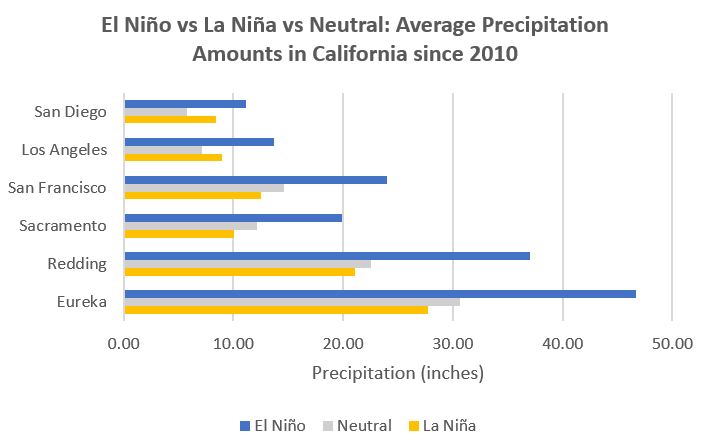Matt Muilenburg, QISP, Water Resource Specialist at NV5
Continuing throughout the winter, El Niño is anticipated to bring a substantial increase in rainfall to California. In preparing for the potential challenges presented by heavy rainfall during El Niño events in California, NV5 can assist your business by addressing these considerations, thereby enhancing your readiness to navigate and mitigate the impacts effectively.
What are El Niño and La Niña?
As pivotal components of the El Niño-Southern Oscillation (ENSO) cycle, El Niño and La Niña represent opposing phases, influencing sea surface temperatures and atmospheric conditions. El Niño is characterized by warmer-than-average sea surface temperatures in the central and eastern equatorial Pacific Ocean, with significant impacts on global weather patterns, including increased rainfall in California. Typically associated with wetter conditions in California, El Niño contrasts with La Niña, which is generally linked to drier conditions. The graph below analyzes historical average precipitation data from key regions in California since 2010. Over this period, El Niño has shown a correlation with increased rainfall compared to La Niña and ENSO-neutral winters.
Recognizing historical patterns and preparing for heavy rainfall are essential for businesses, particularly those in environmental consulting and engineering. The following considerations outline key factors for businesses based on the historical impact of heavy rainfall during El Niño years in California:
Increased Demand for Flood Risk Assessment:
Prepare for a potential surge in demand for flood risk assessments due to elevated flooding risks from heavy rainfall. Assess vulnerabilities in infrastructure and formulate flood control strategies to enhance preparedness.
Enhanced Stormwater Management Planning:
Anticipate the need for comprehensive stormwater management plans to address higher runoff volumes associated with heavy rainfall. Develop and implement effective strategies to mitigate erosion, flooding, and water quality issues.
Infrastructure Resilience Evaluation:
Evaluate the resilience of existing infrastructure to withstand heavy rainfall and potential flooding. Consider upgrades or modifications to enhance infrastructure systems’ capacity to cope with extreme weather events.
Erosion and Sediment Control Measures:
Implement proactive erosion and sediment control measures to counteract the increased risk of soil erosion during heavy rainfall. Design structures and practices to prevent sedimentation in water bodies.
Water Quality Monitoring and Management:
Intensify water quality monitoring efforts during El Niño years to identify and address potential pollution issues associated with heavy rainfall. Develop strategies to manage and mitigate the impact of contaminants on water bodies.
Regulatory Compliance and Adaptation:
Verify compliance with evolving regulations and proactively adapt business practices to meet new standards.
Emergency Response Planning:
Develop and update emergency response plans to address potential damages caused by heavy rainfall. Prepare for rapid response and recovery efforts, including assessments, technical expertise, and support for affected communities.
Climate-Resilient Solutions:
Consider incorporating climate-resilient solutions into consulting and engineering projects. Design infrastructure and environmental management systems capable of withstanding the impacts of changing weather patterns.
Public Outreach and Education:
Engage in public outreach and education initiatives to inform communities about heavy rainfall risks. Promote awareness of sustainable water management practices and emphasize the role of consulting businesses in building resilience.
By proactively addressing these considerations, businesses in environmental consulting and engineering can enhance their readiness to navigate the challenges posed by heavy rainfall during El Niño events in California. This strategic approach contributes to the overall resilience and sustainability of both businesses and communities in the face of evolving weather patterns. For assistance, please contact us at 858.385.0500 or reach out to Matt Muilenburg, Water Resource Specialist at Matt.Muilenburg@nv5.com.


